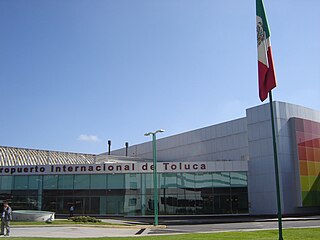Aerovías de México, S.A. de C.V. operating as Aeroméxico, is the flag carrier of Mexico, based in Mexico City. It operates scheduled services to more than 90 destinations in Mexico; North, South and Central America; the Caribbean, Europe, and Asia. Its main base and hub is located in Mexico City, with secondary hubs in Guadalajara and Monterrey. The headquarters is in the Torre MAPFRE on Paseo de la Reforma.

Compañía Mexicana de Aviación S.A. de C.V., usually shortened to Mexicana de Aviación, was Mexico's oldest airline and one of the oldest continuously single-branded airlines, inaugurated in 1921. It was Mexico's biggest airline and flagship airline before ceasing operations on August 28, 2010, leaving competitor Aeroméxico as a de facto monopoly.

The Boeing 717 is an American five-abreast narrow-body airliner produced by Boeing Commercial Airplanes. The twin-engine airliner was developed for the 100-seat market and originally marketed by McDonnell Douglas in the early 1990s as the MD-95 until the company merged with Boeing in August 1997. It was a shortened derivative of McDonnell Douglas’ successful airliner, the MD-80, and part of the company's broader DC-9 family. Capable of seating up to 134 passengers, the 717 has a design range of 2,060 nautical miles [nmi]. It is powered by two Rolls-Royce BR715 turbofan engines mounted at the rear of the fuselage.

Air Canada Tango was a low-cost subsidiary branch of Air Canada, which was established in 2001 to offer no-frills service on some of Air Canada's routes and to reduce operating costs at the struggling main company. Based in Toronto, Tango operated on the major longer-distance Canadian routes between cities such as Toronto, Ottawa, Montreal, Calgary and Vancouver, as well as to some holiday destinations in the USA and Mexico such as Fort Lauderdale, Seattle, Tampa and Mexico City.
AirTran Airways was a low-cost airline in the United States that operated from 1993 until 2014, when it was merged into Southwest Airlines.
Impulse Airlines was an Australian airline which operated regional and low-cost trunk services between 1992 and 2004. It was acquired by Qantas in 2001 to form the basis of Qantas' new regional airline QantasLink. The airline had its head offices on the grounds of Sydney Airport in Mascot.

TAESA Flight 725 was a scheduled flight originating in Tijuana International Airport and ending at Mexico City International Airport with intermediate stopovers in Guadalajara and Uruapan, that crashed shortly after departure from the latter city's airport on November 9, 1999, killing all 18 passengers and crew on board. The crash led TAESA to ground its fleet and suspend operations a year later in 2000.

Líneas Aéreas Azteca was an airline based in Mexico City, Mexico. It operated domestic scheduled services and international services to the USA. Its main base was Mexico City International Airport, with a hub at General Abelardo L. Rodríguez International Airport, Tijuana.

TAESA was a low cost airline with its headquarters in No. 27 of Hangar Zone C on the grounds of Mexico City International Airport in Mexico City, Mexico.

MexicanaClick, formerly Click Mexicana, was Mexicana's regional operator, serving most of Mexicana's domestic routes between more than 25 Mexican cities. It was founded as a low-cost carrier, but changed its market to regional operations after its acquisition by Mexicana. Its main base was Mexico City International Airport.

Toluca International Airport ; officially Aeropuerto Internacional Licenciado Adolfo López Mateos(Licenciado Adolfo López Mateos International Airport) is an international airport in Toluca, State of Mexico, Mexico. It handles both national and international air traffic for the Metropolitan area of Toluca and serves as a secondary airport for Greater Mexico City, alongside Felipe Angeles Airport. Historically serving as a hub for Volaris, Interjet, and Republicair, the airport is operated by Administradora Mexiquense del Aeropuerto Internacional de Toluca and is named after President Adolfo López Mateos.

RepublicAir was a Mexican airline founded in 2004. It is based at Toluca International Airport, in the city of Toluca, Mexico. Republicair was banned from its operations by DGAC in April 2007, but as of July 2007 they returned and restarted operations with a single Boeing 737-200
Coculum Aeronáutica S.A. de C.V. was a Mexican airline that operated from 1948 to 1962.

Aviación del Noroeste S.A de C.V was a Mexican airline based in Hermosillo, Mexico. It was shut down in 1995 and is currently defunct.
Aero Jet Express Internacional SA de CV is a Mexican airline based in Mexico City.

Servicios Aéreos Rutas Oriente, S.A. de C.V. was an airline based in Monterrey, Mexico. The airline was established in 1991 and had its first flight on March 18 of that year. Due to their low prices, SARO was one of the first low-cost airlines in Mexico and America. It operated scheduled and charter flights throughout the Mexican Republic. SARO ceased all operations in 1995.
Puebla Air Lines was a Mexican airline based in Puebla, Puebla. The airline started operations in 1985 and operated scheduled services until 1995.
Eastern Airlines, LLC is an American airline founded in 2010. It operates Boeing 767s and Boeing 777s. It began as Dynamic Airways and later added "International" to its name to reflect its transition from a charter airline into scheduled international services. Under the Dynamic name, the airline was headquartered in High Point, North Carolina, offering service from New York to South America. It used to operate from Fort Lauderdale, Chicago, Los Angeles, and New York to the Caribbean, Cancún, and South America.

TUM Aerocarga is a Mexican cargo airline owned by MCS Holding Cargo Services and Grupo TUM.

Servicios Aerolineas Mexicanas, also known as SAM was a Mexican airline that operated between 1992 and 1995. It was part of the first wave of newly formed airlines following the Mexican airline deregulation of 1989. At its height in 1994, it operated a fleet of 3 Douglas DC-9-10 and 1 Boeing 737-200 aircraft. Severely affected by the Mexican peso crisis, SAM ceased all operations in April 1995.












